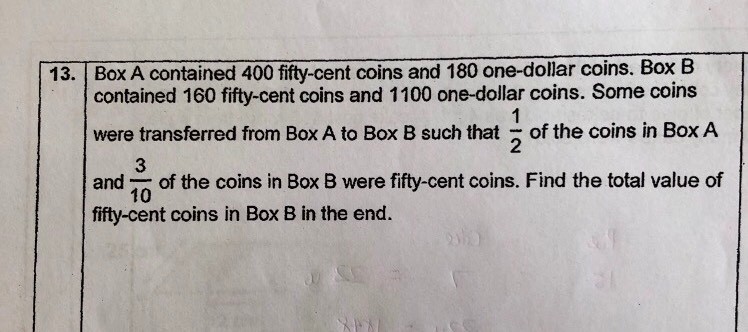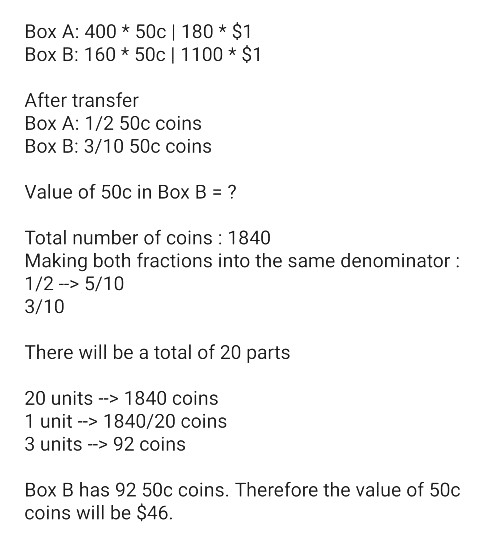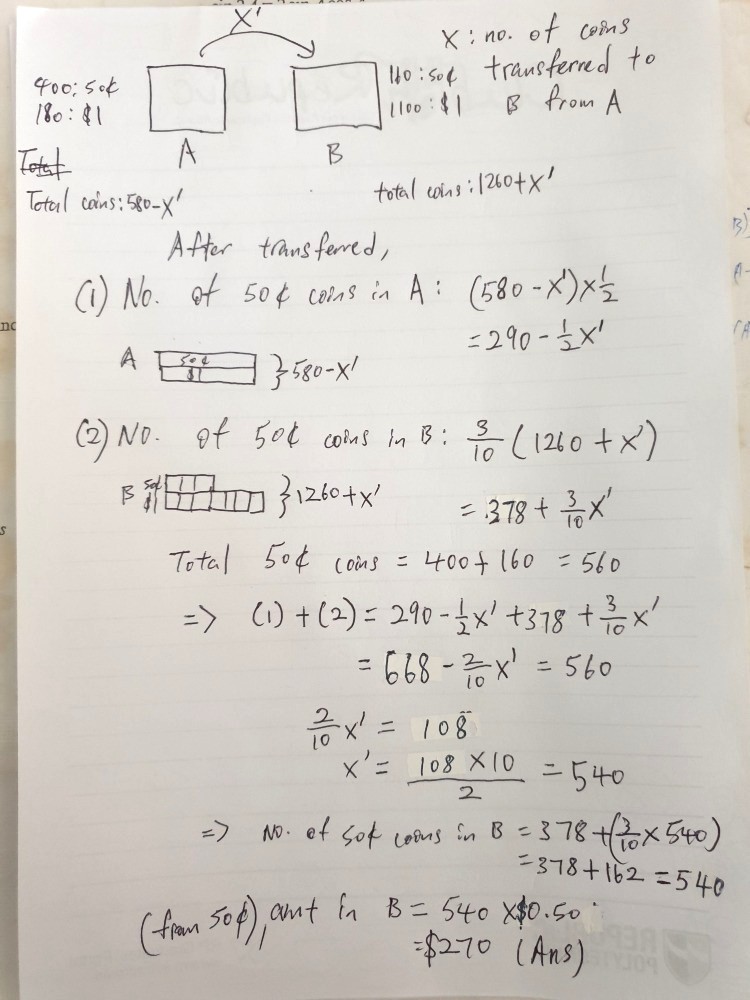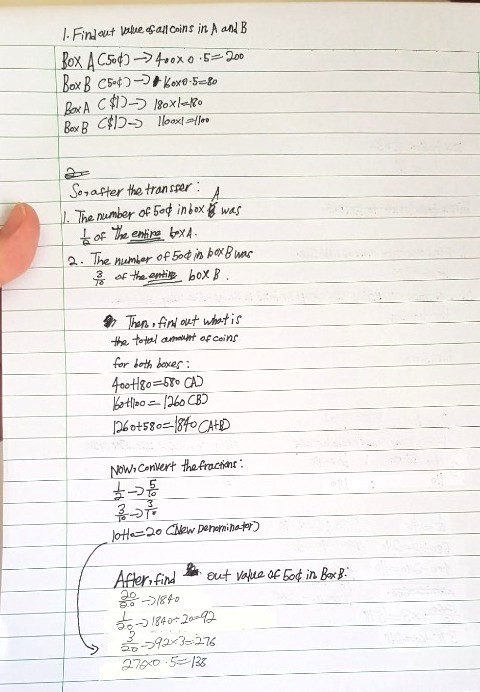Ask Singapore Homework?
Upload a photo of a Singapore homework and someone will email you the solution for free.

Question
primary 6 | Maths
| Fractions
4 Answers Below
Anyone can contribute an answer, even non-tutors.

Pls help . Tks
Box A: 400 pieces 50c, 180 pieces $1
Box B: 160 pieces 50c, 1100 pieces $1
Some 50c coins and some $1 coins are transferred from Box A to Box B
After:
Box A: 50% are 50c coins
Box B: 30% are 50c coins
Now, there are a total of 1840 coins, comprising a total of 560 pieces of 50c coins and 1280 pieces of $1 coins.
Because Box A is to have 50% of 50c coins at the end, there must be an equal number of 50c coins and $1 coins in Box A at the end.
This means that there are 220 more pieces of 50c coins than $1 coins being transferred from Box A to Box B, because currently there are 220 more pieces of 50c coins than $1 coins. So for example, if 100 pieces of $1 are being transferred, then 320 pieces of 50c coins are being transferred.
At this part do you understand the idea behind the transfer?
Now, let’s consider Box B.
Currently there are 940 more pieces of $1 coins than 50c coins in Box B, if you have done the counting. Because Box B is about to receive 220 more pieces of 50c coins than $1 coins, at the end of the transferring, Box B will only have 720 more pieces of $1 coins than 50c coins.
At the end, Box B has 720 more pieces of $1 coins than 50c coins, and the number of 50c coins in Box B is 30% (3/10) of the total number of coins in Box B.
There are “3 units” of 50c coins in Box B at the end and “7 units” of $1 coins in Box B at the end, so that the total number of coins in Box B at the end is “10 units”. The difference of 4 units in coins between the two corresponds to the 720 extra coins.
So in other words,
4 units —> 720 coins
1 unit —> 720/4 = 180 coins (“fraction” and “divide” mean the same thing actually but I cannot find a division symbol here)
3 units —> 180 x 3 = 540 coins
So there must be 540 pieces of 50c coins in the end.
This totals $270 in 50c coins in Box B in the end, since every two pieces of 50c coins equal to $1 in value.
———————————————
Let’s check the above.
7 units —> 180 x 7 = 1260 coins
So there are 540 pieces of 50c coins and 1260 pieces of $1 coins at the end.
Because Box B started out with 160 pieces of 50c coins and 1100 pieces of $1 coins at first, there must have been 380 pieces of 50c coins and 160 pieces of $1 coins being collected by Box B in the transfer, which comes from Box A.
Box A has 20 pieces of 50c coins and 20 pieces of $1 coins in the end, which explains why the percentage of 50c coins in Box A at the end is 50%.
So there must really be 540 pieces of 50c coins in Box B at the end, amounting to $270.
——————————————
I cannot guarantee and vouch for the correctness of my answers, but I have tried to keep my ideas logical for this question.
If you still do not understand my workings, let me know accordingly.
As for the 3 units calculation, I believe you found an error in my answer. It is indeed 92 × 3 to get 276 50c coins. Therefore the correct answer should be $138.
276 × 50c = $138
Before
Box A: 400 pieces 50c, 180 pieces $1
Box B: 160 pieces 50c, 1100 pieces $1
Transfer made is 380 pieces 50c, 160 pieces $1
After
Box A: 20 pieces 50c, 20 pieces $1 (so percentage of 50c is 50%, i.e. 1/2 of the coins in Box A are 50c coins at the end)
Box B: 540 pieces 50c, 1260 pieces $1 (so percentage of 50c is 30%, i.e. 3/10 of the coins in Box B are 50c coins at the end)
For a total value of $270 worth of 50c coins in Box B.
Instead, we are counting the number in terms of transfers.
At first, there are 400 pieces of 50c coins and 180 pieces of $1 coins in Box A. I anticipate that there must be an equal number of pieces of 50c coins and $1 coins at the end in Box A, because half of the coins in Box A at the end must be 1/2.
Howsoever you try to do the transfer to meet these requirements, you would have transferred 220 more pieces of 50c coins than $1 coins to Box B.
For example, if you wish to leave behind 100 pieces of 50c coins and 100 pieces of $1 coins at the end, you will need to transfer 300 pieces of 50c coins and 80 pieces of $1 coins, with a net difference of 220 coins.
Similarly, if you wish to leave behind 50 pieces of 50c coins and 50 pieces of $1 coins at the end, you will need to transfer 350 pieces of 50c coins and 130 pieces of $1 coins, also with a net difference of 220 coins.
However, only one such combination leaves Box B with 30% of 50c coins at the end.
Box B starts out with 940 more $1 coins than 50c coins. As a result of the transfer, this gap “narrows” to 720 more $1 coins than 50c coins.
It’s like you are running a race and you are 940 m in front of your classmate. Suddenly your classmate runs faster and ends up closing up the gap by 220 m because you ran more slowly. You are still ahead 720 m at the end.
Note that this “220 more 50c coins than $1 coins being transferred” has no relationship with “240 more 50c coins in Box A than Box B at first”.
This extra 4 units correspond to this extra 720 pieces of coins.
Working out everything, 3 units yield 540 pieces of coins.
So there are 540 pieces of 50c coins at the end.
At the end, there are 276 pieces of 50c coins in the end.
Since the ratio of 50c coins to $1 coins at the end is 3:7, there must have been (276 / 3 x 7) = 644 pieces of $1 coins at the end.
It does not make logical sense for 1100 pieces of $1 coins in Box B to drop to 644 pieces of $1 coins in Box B at the end, since the Box B is supposed to gain pieces of $1 coins from Box A.
So there could not have been 276 pieces of 50c coins in Box B at the end.
Take your time to analyse the question, understand the ideas and plan a working to solve the question. You can notify me if you think my workings have errors and I will check once again my answers.
Let me know through this question’s chat box if you have further queries.
See 4 Answers
In summary, I got these:
Before
Box A: 400 pieces 50c, 180 pieces $1
Box B: 160 pieces 50c, 1100 pieces $1
Transfer made is 380 pieces 50c, 160 pieces $1
After
Box A: 20 pieces 50c, 20 pieces $1 (so percentage of 50c is 50%)
Box B: 540 pieces 50c, 1260 pieces $1 (so percentage of 50c is 30%)
For a total value of $270 worth of 50c coins in Box B.
160 pieces of 50c coins
at first, so there could not have been
92 pieces of 50c coins
in Box B at the end, considering that coins are being transferred from Box A to Box B but no coins are being transferred from Box B to Box A.
Edit: Had not seen your updated comments of 276 coins in time.
The fractions 1/2 and 3/10 in “1/2 of 100 coins and 3/10 of 100 coins” can be added
but
the fractions 1/2 and 3/10 in “1/2 of 100 coins and 3/10 of 500 coins” cannot be added.


Otherwise, write the x in the usual curvy way










